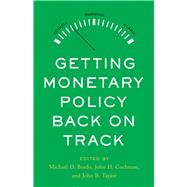In May 2023, the world’s top economic policymakers and academics convened at the Hoover Institution for the annual Monetary Policy Conference. They met at a tumultuous time: the previous year, inflation had surged, and some believed the Federal Reserve was slow to react. What was behind this surge, and why did the Fed fail to forecast inflation, or perceive it when it happened? Participants considered whether the sluggish response made the situation worse, and how to get inflation back under control.
This volume presents the full proceedings from this conference—the presentations, responses, and discussions. In it, participants debate the meaning of getting monetary policy “back on track,” the significance of recent bank failures, and how to improve forecasting and oversight. A persistent underlying question is whether the Fed should follow a rule-like monetary policy, which maintains predictability in response to fluctuating inflation, GDP, and employment rates. Presenters discuss this issue as they recognize the thirtieth anniversary of the Taylor rule, an important guide to practical monetary policy.
Other topics include a five-century history of central bank balance sheets, inflation targeting in Japan, and lessons from Latin America. Together, these proceedings illustrate and dissect the interaction of financial regulation and monetary policy.









